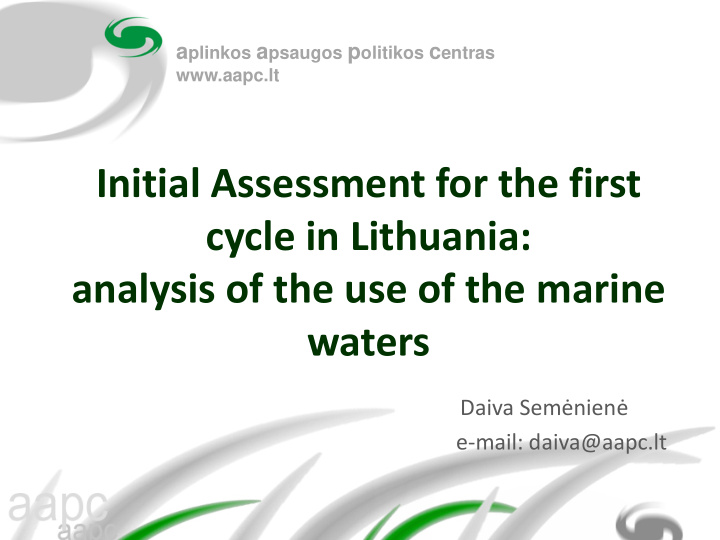



a plinkos a psaugos p olitikos c entras www.aapc.lt Initial Assessment for the first cycle in Lithuania: analysis of the use of the marine waters Daiva Sem ė nien ė e-mail: daiva@aapc.lt
Current status of the MSFD implementation • The MSFD related Programme of Measures is not yet approved • Activities related to the second cycle of the MSFD implementation have not been started yet 2
Objectives (steps) of the economic and social analysis during the Initial Assessment Initial Assessment Assessment of driving Economic and Assessment of forces and pressures social analysis current status 1. Identify and describe the 2. Describe in qualitative terms and, if possible, in different uses of the marine environment in terms of quantitative terms the their economic and social cost of degradation of the marine environment importance and pressures 3
Initial Assessment for the first cycle carried out on time The initial assessment of the current environmental status of national marine waters and the environmental impact and socio- economic analysis of human activities in these waters 2008 2009 2010 2011 2012 2013 2014 2015 2016 2017 2018 2019 2020 4
Method applied • Marine Water Account approach • The cost of degradation is assessed according descriptors. Depending on data availability, ecosystem service approach or cost-based approach was applied.
Steps completed during the analysis of the use of marine waters 1. Review and selection of value categories related to the use of the marine waters relevant for Lithuania 2. Review and selection of the economic sectors relevant to Lithuania 3. Description of all sectors related to the use of the marine waters according to their economic and social importance and pressures. Analysis of the key sectors in order to determine their value added, production value and employment 4. Comparison of the social and financial benefit provided by all economic sectors related to the use of the marine waters with the corresponding indicators of Lithuania and Klaipėda county
Uses of marine waters analysed and described Direct uses Indirect use values Non-use values -Shipping Ecosystem regulating functions : climate Altruistic values -Ports regulation, decomposition of waste and Bequest values and -Fisheries water purification /detoxification, Existence values -Tourism erosion control and protection against -Energy and natural disasters telecommunications Ecosystem supporting functions : -Oil refining maintenance of biogeochemical cycling, (company Orlen supporting primary production, Lietuva) maintenance of food web dynamics, -Agriculture, industry, biodiversity and habitats, maintenance households of resilience. Provisioning and cultural + Five studies on monetised assessment of the environmental status as well as two non-monetised studies on the use of the Baltic Sea and the impact of its quality on business were also described. The studies were conducted in Lithuania over the period 1993–2012.
Value of sectors – direct users Production Value Number of Sector value, added, employees mEUR/year mEUR/year Shipping and ports 243 110 2 960 Sectors related to shipping and ports 1 274 284 21 400 Fisheries 15 3 530 Tourism and recreation 23 10 2 150 Institutions funded by the State 2 000 Total: ~1 535 ~405 ~30 000 Share in the indicators of Klaipėda county 13,6% 18,2% Share in the indicators of the Republic of Lithuania ~2% 2,1%
Challenges: data architecture • Very difficult to separate coastal activities from land-based ones. • Very difficult to separate the statistics dealing with the specific marine region from the overall statistics of that particular activity in the world. • Lack of data on certain descriptors. • Lack of impact data (a huge problem).
Knowledge gaps faced during the 1st IA (1) • Unclear GES • Links between descriptors and drivers/pressures; the relationship between descriptors and ecosystem services. • No knowledge on noise • Insufficient monitoring, thus not enough data for making assessment even in those cases when some monetary elements exist
Knowledge gaps faced during the 1st IA (2) • Importance of joint international efforts • There is not yet a “common language” in understanding some MSFD terms, e.g. cost of degradation.
Priority needs identified during the first IA (1) • Need to systemise and disseminate methods other than monetary valuation • A great need for research on the relationship between pressures by certain economic activities on descriptors/indicators/ecosystem services • Short-term advice on how to construct the Programme of Measures when GES for certain descriptors and indicators is not set
Priority needs identified during the first IA (2) • Work on the instruments for selection of the most cost-effective options for measures • Work on monetary assessment of ecosystem services • Research on behavioural aspects
Thank you!
Esamų ir naujų priemonių JSPD -ai įgyvendinti preliminarios sąnaudos, tūkst.Lt Tiesiogiai jūrą veikiančių Esamų Naujų Jūros aplinkos sektorių ekonominiai priemonių priemonių blogėjimo/gerėjimo socialiniai rodikliai sąnaudos sąnaudos * sąnaudos/nauda be Nemuno Jūros Naftos Eutrofika UBR Pardavim paukščių produktais cija / priemonių Darbu o priegauda išteptų Vandens Pridėtinė otojų pajamos žvejybos paukščių skaidrum vertė skaiči / įrankiuose žūtis as us apyvarta 5342000 1401000 29500 4000 1300 140 55400 2012 1800 (2016 m.) 2020 Prognozių piniginiam 31300 2000 Rodikliai turėtų gerėti vertinimui nepakanka
Recommend
More recommend